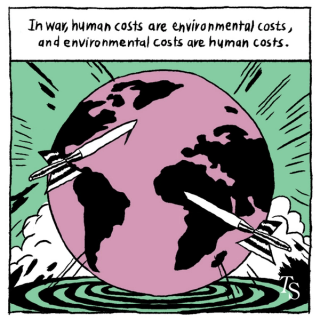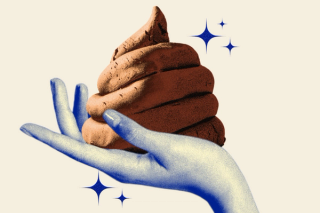
That’s Weird: Fecal Transplants
Fecal microbiota transplants, which cure severe gastrointestinal diseases and potentially alleviate diabetes, mental illness, and more, are too good to be true. Almost.

In ‘Weird,’ we explore science’s strangest developments and discontents.
“As the sun set over Lake Eyasi in Tanzania, nearly thirty minutes had passed since I had inserted a turkey baster into my bum and injected the feces of a Hadza man – a member of one of the last remaining hunter-gatherer tribes in the world – into the nether regions of my distal colon.” This is the opening sentence of anthropologist Jeff Leach’s essay. He performed a procedure that isn’t just changing medicine but also our relationship with our bodies, the idea of waste, and our disgust with what we view as “contamination.”
Fecal microbiota transplants (FMTs) are exactly what they sound like. The procedure involves transferring fecal matter from a healthy donor into a patient’s gastrointestinal (GI) tract in order to restore the patient’s healthy gut microbe composition. The earliest records of FMTs go back to 4th century China, where “yellow soup” transfer was used to treat Clostridium difficile infection, a sometimes fatal disease, which today is unresponsive to antibiotics after a point. FMTs resurfaced in recorded history in 1958. Since then, they’ve challenged a deeply held, pervasive, and subconsciously anchored fear in most humans: what anthropologist Mary Douglas called “dirt out of place.” FMTs turn something seen as polluting and worthy of disposal into an asset, even a precious resource.
This is because their results are nearly miraculous. Many patients with serious GI diseases are cured within a day. In one trial that compared FMTs to antibiotic treatment, researchers had to stop the trial because the fecal transplants were so effective that it became unethical to continue to treat the other group with antibiotics. In fact, no other medical treatment is associated with a recovery rate so high or so fast. FMTs are even being considered the next frontier in the treatment and prevention of cancer and other non-GI diseases, such as obesity, inflammation, and depression. Many regulatory bodies, including those in the USA and Canada, now consider stool to be a biological “drug.” That’s why there are now stool banks to preserve healthy gut microbes from donors across the world, including patients who want to preserve their stool for later in life.
The science of fecal transplants goes like this: The gastrointestinal system is colonized by thousands of species of microbes, all of which play important roles in regulating not just our gut health but also our immunity, mental health, cardiovascular health, and more. But antibiotics and environmental, lifestyle, and other stressors are changing the composition of our gut. As a result, we’re not only losing precious species from our bodies, but also the right ecosystem balance of species which keeps us healthy. Enter: other people’s microbes. Everyone’s gut microbial composition is different; some are better than others, depending on their histories and current lifestyles. The greater the diversity of the gut microbiome, the healthier the balance. When healthy donors’ microbiome enters the GI tract of someone with a disease, it acts as a reset.
Why stool? Our gastrointestinal tract contains a rich, diverse blend of gut bacteria (the greater the diversity, the better) We share a symbiotic relationship with these colonies of microorganisms – they help us metabolize food, we help them sustain a colony. But stool, in particular, is a bodily substance that’s readily available and contains a significantly large concentration of these microbes – making it the most viable substance for transplanting. The hope for the future is that one day, when we’re able to figure out the right balance and concentration of all the diverse types of bacteria, we may not need actual stool. But for now, if you really get down to the icky details: there are over 100 billion bacterial cells in a gram of wet stool – 49% of these viable, 19% injured, and 32% dead. But even dead DNA and bacteria “might retain some immunostimulatory functions.” There are more bacteria in our entire gut than there are cells in our bodies. The potential supply of lifesaving therapy from a healthy donor is virtually limitless.
So why aren’t they more popular? One factor is the stigma around the procedure, which many patients and practitioners are beginning to try and fight. One researcher attributes the still-pervasive taboo of FMTs to “the fading of an agrarian life that equated manure with opportunity, whose cultural influence is now drowned out by public health warnings of diarrhoea-borne epidemics in towns and cities.” “Probably of all of the elicitors of disgust that we’ve collected from studies around the world, [feces is] the most universal,” says Valerie Curtis, from the London School of Hygiene and Tropical Medicine, who calls herself a “disgustologist.”
But more than that, there's still a lot we don’t know about FMTs from a science point of view. Donor-recipient compatibility is hard to gauge, owing to the millions of teeming microbes to consider. Though the consequences of incompatibility aren’t as severe as those of organ transplants, they still raise the possibility of infections from unknown bacteria in donor stool. In 2019, for example, an immunocompromised person died from the procedure, Because the donor’s stool hadn’t been screened for a strain of resistant E. coli. It raised questions about how to donors can be screened for compatibility. Unlike other tissue or organs, stool is relatively harmless, but it does carry unique microbial signatures of a person. This could mean we could accidentally transfer gut compositions that make recipients prone to diabetes or inflammation, even if the donor isn’t. Still, when done right, the success rate of the procedure far outweighs the failures – so far.
How the feces is transferred brings us into closer contact with it than we’re used to. Colonoscopies, endoscopies, and enemas are a few ways to do so. But the most practical method is one that remains the most indigestible: the “crapsule,” as it’s half-jokingly called. It’s a capsule containing a tiny bit of someone else’s feces. And you take it the same way you would any other pill: by swallowing it.
Linda Geddes, a regular stool donor, describes the last process in minute, uncomfortable detail. “It’s not often we hand over something so intimate, nor so laden with cultural taboos, to a fellow human,” she says. But the biomedical scientist performing the task isn’t as fazed. “[The scientist] reassures me that she views faeces as ‘just another type of specimen… not much worse than blood.’” Her poop is shaken in a saline solution, filtered to sediment out undigested food, put in a centrifuge, and turned into a “cake” of bacteria. This is transferred into a capsule, which the recipient will orally swallow – not knowing where it came from. Donors are anonymous, as stool banks collect samples from people all over the world.
Here’s where the emerging ethical issues with FMTs arise: the question of who the best donors are.
Feces is biopolitical: the disgust we feel about it creates an innate, subterranean sense of “inside” and “outside”, and makes people instinctively separate themselves from others based on an imagined barometer of civility. It’s arguably this primal fear of the other which is the key question FMTs raise – whose shit do you swallow? We’ve used the aversion of feces as a tool to violently impose hierarchy and order in society in the name of hygiene. “Physical dirt becomes social dirt, physical contamination social contamination, and hygiene a social necessity,” van der Geest writes. The visceral aversion to the substance makes the question of subjects a political one.
The healthiest stool is increasingly a scarce, precious resource too. That’s because modern environments have misplaced ideas of sanitation and health – and the more we keep ourselves away from nature, dirt, and other species, the less diverse our gut microbiome is; the more exposed to pollutants and bad diets we are, the greater the threat to our existing microbiome. Moreover, the percentage of people who have never used antibiotics – which kill good and pathogenic bacteria indiscriminately – and who therefore have an untarnished gut microbiome, is exceedingly slim. Industrial countries, who created sterile environments for themselves, are the worst off when it comes to gut diversity. Scientists have called an intact microbiome a “disappearing resource.”
Ironically, the search for the “purest” stool took researchers to communities who have historically been demonized as “unhygienic” and “uncivilized.” Enter: the Hazda, one of the last hunter-gatherer tribes who still live where homo sapiens originated. Hazda – untouched by modernity, including antibiotics, and closely in contact with nature – may contain the world’s oldest and most diverse gut microbiome. Studies showed they have several species of microbes which don’t even exist in Western populations. And they’re just one of many tribal communities science is beginning to look to as sources of healthy stool samples.
FMT research transformed a substance at the center of hygiene panics and governance – which created social hierarchies of “us” versus “other” – into one now highly coveted from the “other”. Indigenous and tribal populations’ feces is now an invaluable resource for Western populations whose gut microbiomes were ravaged by the pace of their own "progress." “To restore microbial diversity, researchers have turned to isolated indigenous tribes like the Yanomami, a group believed to be among the last to house a semblance of humankind’s rich ancestral microbiome,” Undark Magazine notes. There are health concerns to transplanting feces from someone unknown to a patient, without knowing the composition. And that’s what researchers are looking for: collecting stool from indigenous communities helps us document what a healthy gut microbiome looks like and is composed of, before it disappears forever. But collecting bodily materials has always been fraught with ethical transgressions in the past. The result is a new uncomfortable social dynamic: instead of colonizing communities for their perceived inferiority, we’re now on the path to colonizing bodies for their superior internal resources.
“History is rife with examples of researchers who have ignored the cultural values of participants, objectified them as one-dimensional pools of information, and failed to compensate them for their contributions.”
“The scientists collecting these samples can’t just be concerned with the data they generate,” Undark added, quoting Maria Gloria Dominguez Bello, a collaborator of Caballero Arias. “What’s established between researcher and study participant, she says, should be a long-term relationship that protects the people involved as much as it advances the science.”
Moreover, FMTs aren’t a silver bullet to solve the problem of our rapidly changing gut diversity. At best, FMTs are a stopgap to recognizing the real problem: industrialization, climate change, forced displacement, and broken food security systems. Where does that leave us? FMTs are indeed lifesaving interventions, but they also show us the costs of industrializing without regard for human health. And so we realize we’re more than just our physical bodies, and singular treatments aren’t enough without holistic changes to our environments. As one study puts it: “The human microbiome, fecal therapeutics and being disgusted give us an opportunity to recognise ourselves as more-than-human subjects.” FMTs, then, don’t just change disgust. They prompt a complete overhaul of how we’ve lived our lives in the name of modernity – and what it would take to reverse the damage before it’s too late.
Rohitha Naraharisetty is a Senior Associate Editor at The Swaddle. She writes about the intersection of gender, caste, social movements, and pop culture. She can be found on Instagram at @rohitha_97 or on Twitter at @romimacaronii.
Related


How Apple Defies Consumer Logic
